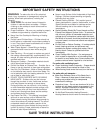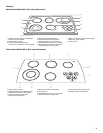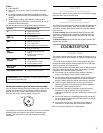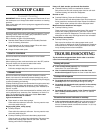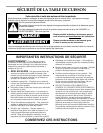
10
COOKTOP CARE
General Cleaning
IMPORTANT:
Before cleaning, make sure all controls are off and
the cooktop are cool. Always follow label instructions on cleaning
products.
Soap, water and a soft cloth or sponge are suggested first unless
otherwise noted.
STAINLESS STEEL
(on some models)
Do not use soap-filled scouring pads, abrasive cleaners, Cooktop
Polishing Creme, steel-wool pads, gritty washcloths or some
paper towels. Damage may occur.
Rub in direction of grain to avoid damaging.
■
Stainless Steel Cleaner & Polish (not included): See back
cover for ordering information.
■
Liquid detergent or all-purpose cleaner: Rinse with clean
water and dry with soft, lint-free cloth.
■
Vinegar for hard water spots.
COOKTOP CONTROLS
Do not use steel wool, abrasive cleansers or oven cleaner.
Do not soak knobs.
When replacing knobs, make sure knobs are in the OFF position.
On some models, do not remove seals under knobs.
■
Soap and water or dishwasher:
Pull knobs straight away from control panel to remove.
CERAMIC GLASS
Do not use steel wool, abrasive powder cleansers, chlorine
bleach, rust remover or ammonia because damage may occur.
Always wipe with a clean, wet cloth or sponge and dry thoroughly
to prevent streaking and staining.
Cooktop Polishing Creme is recommended for regular use to help
prevent scratches, pitting and abrasions, and to condition the
cooktop. It may be ordered as an accessory. See “Assistance or
Service” to order.
A Cooktop Scraper is also recommended for stubborn soils, and
can be ordered as an accessory. See “Assistance or Service” to
order. The Cooktop Scraper uses razor blades.
Store razor
blades out of the reach of children.
Light to moderate soil
■
Paper towels or clean damp sponge:
Clean while the cooktop is still warm. You may want to wear
oven mitts while doing so.
Sugary spills (jellies, candy, syrup)
■
Cooktop Scraper:
Clean while the cooktop is still warm. You may want to wear
oven mitts while doing so.
■
Cooktop Polishing Creme and clean damp paper towel:
Clean as soon as cooktop has cooled down. Rub creme into
surface with a damp paper towel or soft cloth. Continue
rubbing until white film disappears.
Heavy soil, dark streaks, specks and discoloration
■
Cooktop Polishing Creme or nonabrasive cleanser:
Rub product into soil with a damp paper towel or soft cloth.
Continue rubbing until white film disappears.
Burned-on soil
■
Cooktop Polishing Creme and Cooktop Scraper:
Rub creme into soil with damp paper towel. Hold scraper as
flat as possible on surface and scrape. Repeat for stubborn
spots. Polish entire cooktop with creme and paper towel.
Metal marks from aluminum and copper
■
Cooktop Polishing Creme:
Clean as soon as cooktop has cooled down. Rub creme into
surface with a damp paper towel or soft cloth. Continue
rubbing until white film disappears. The marks will not totally
disappear but after many cleanings become less noticeable.
Tiny scratches and abrasions
■
Cooktop Polishing Creme:
Rub creme into surface with a damp paper towel or soft
cloth. Continue rubbing until white film disappears. Scratches
and abrasions do not affect cooking performance and after
many cleanings become less noticeable.
TROUBLESHOOTING
Try the solutions suggested here first in order to avoid the
cost of an unnecessary service call.
Nothing will operate
■
Is the cooktop wired properly?
See “Installation
Instructions” for more information.
■
Has a household fuse been blown or has the circuit
breaker been tripped?
Replace the fuse or reset the circuit.
Cooktop will not operate
■
On models with knob controls, is the control knob set
correctly?
Push in the knob before turning to a setting.
■
On models with electronic touch controls, is the cooktop
control set correctly?
Touch ON/OFF before selecting a
setting.
■
On models with touch controls, is the “Control Lock/ALL
OFF” Cooktop Lockout set?
See “ALL OFF” or “Control
Lock” sections.
Excessive heat around cookware on cooktop
■
Is the cookware the proper size?
Use cookware about the
same size as the surface cooking area, element or surface
burner. Cookware should not extend more than 1 in. (2.5 cm)
outside the cooking area.




